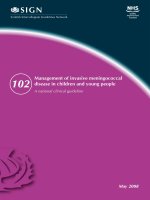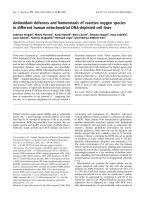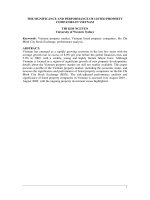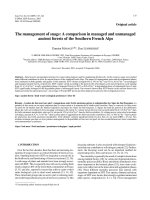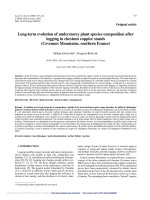Risks, impacts and management of invasive plant species in vietnam
Bạn đang xem bản rút gọn của tài liệu. Xem và tải ngay bản đầy đủ của tài liệu tại đây (10.37 MB, 314 trang )
Risks, impacts and management of invasive
plant species in Vietnam
Thi Anh Tuyet Truong
BA MSc
Submitted in fulfilment of the requirements for the
Degree of Doctor of Philosophy
School of Veterinary and Life Sciences,
Murdoch University, Australia
2019
i
Declaration
I declare that this thesis is my own account of my research and contains as its main
content work which has not previously been submitted to a degree or diploma at any
tertiary education institution.
Human ethics
The research in chapter 5 presented and reported in this thesis was conducted in
accordance with the National Statement on Ethical Conduct in Human Research (2007),
the Australian Code for the Responsible Conduct of Research (2007) and Murdoch
University policies. The proposed research study received human research ethics
approval from the Murdoch University Human Research Ethics Committee, Approval
Number 2017/033
Thi Anh Tuyet Truong
2019
i
Statement of co-authorship
The following people and institutions contributed to the publication of work undertaken
as part of this thesis:
Chapter 3: Truong, T. T., Hardy, G. E. S. J., & Andrew, M. E. (2017). Contemporary
remotely sensed data products refine invasive plants risk mapping in data poor
regions. Frontiers in Plant Science, 8, 770.
Tuyet T. Truong, Environmental and Conservation Sciences, School of Veterinary and
Life Sciences, Murdoch University, Perth, Australia.
Giles Hardy, School of Veterinary and Life Sciences, Murdoch University, Perth,
Australia.
Margaret Andrew, Environmental and Conservation Sciences, School of Veterinary and
Life Sciences, Murdoch University, Perth, Australia.
Author contributions: TT prepared input data, performed models and interpreted results,
wrote manuscript and acted as corresponding author. MA supervised development of
work, provided guidance throughout the project, and edited manuscript. GH contributed
to editing manuscript.
TT (candidate) (75%), MA (20%), GH (5%).
We the undersigned agree with the above stated “proportion of work undertaken” for
the above published peer-reviewed manuscripts contributing to this thesis.
Signed:
Signed:
Statement
of co-authorship
Thi Anh Tuyet Truong
Margaret E. Andrew
Signed:
Giles E. StJ. Hardy
Date:
ii
Acknowledgements
There are many people that have earned my gratitude for their contribution to this
thesis. My appreciation to all of them for being part of this journey and making this
thesis possible. Special mention goes to my principle supervisor, Dr Margaret Andrew,
for her unflagging academic support, sage advice and attention to detail for every single
part of this thesis. I greatly benefited from her scientific insights and deep
knowledge on invasion science, species distribution modelling and data analysis. My
heartfelt thanks go to Prof. Giles Hardy for accepting me to Murdoch University,
proofing my work and giving me motivation to boost my self-confidence. I owe many
thanks to Prof. Bernie Dell for his invaluable advice and especially his thoroughly
edition for the field experiment chapter. Thank you for always encouraging me, sharing
with me lots of great ideas and also your wittiness. I am much grateful to Dr Mike
Hughes for the time he gave in Chapter 5 to check every transcript, coding and
helping me to redirect myself out of the mess of preliminary results as well as
proofing over and over long, tedious policy drafts. Profound gratitude also goes to
Prof. Pham Quang Thu for his advice on fieldwork design and for the connections he
bridged with interviewees. I am grateful to all my supervisors for your unwavering
mentoring and thoroughly reviewing all of my work. I consider myself very fortunate
being able to work with very considerate and encouraging supervisors like you.
I am also hugely appreciative to Cuc Phuong National Park Management Board for
their support during my experiment. Special thanks to Mr. Quang Nguyen for
supporting and companying me for the three years of the experiment and for sharing
taxonomic expertise so willingly.
I am grateful to all interviewees who were willing to participate in the interviews and
openly share with me their thoughts. Each person I met, each story I heard was of
valuable experience that encourages me to continue to follow the path I am pursuing.
Many thanks to everyone in the Plant Protection Centre of the Vietnam Academy of
Forest Science for hosting cozy lunches. I am grateful for their welcome and support
3
during the time I was in Hanoi. To my Murdoch friends Harish, Rushan, Louise and
Agnes, thank you for coffee time and sharing hard times with me. My thanks also go to
many other Murdoch postgrad students who were willing to share their knowledge in
data analysis and research skills with me.
My special thanks to Australia Award Scholarship (AAS) for financial support to my
thesis and tremendous support to my life in Australia. This project would not have been
possible without this funding and support. I also would like to acknowledge a Murdoch
University Grant to my principal supervisor for funding my field work in Vietnam.
Last but not least, gratitude goes to my family. Words fail to express how indebted I am
to my parents and parents-in-law for their unconditional love, care, and support
throughout my life. Thanks to my brother who accompanied me for day after day
during the experiment in Cuc Phuong National Park. To my husband Hoang Ha and
my son Lam Ha, thank you for patiently bearing with me throughout the up and
down PhD journey and for rebalancing me in times of hardship. Your love gives
me the extra strength and motivation to get things done.
I dedicate this thesis to my beloved family!
4
Abstract
In Southeast Asia, research on invasive plant species (IPS) is limited and biased by
geography, research foci and approaches. This may hinder understanding of the extent
of invasion problems and effective management to prevent and control IPS.
Because biological invasions are a complicated issue involving multiple disciplines,
this thesis utilized diverse approaches to evaluate risk, impacts, and management of IPS
in Vietnam. Distribution models of 14 species predicted that large areas of Vietnam are
susceptible to IPS, particularly in parts bordering China. Native IPS, which are often
overlooked in assessment, posed similar risks as non-native IPS. From the model
results, a native grass Microstegium ciliatum was selected to quantify its impacts on
tree regeneration in secondary forests. A field experiment in Cuc Phuong National
Park found that tree seedling abundance and richness increased within one year of
grass removal; this effect strengthened in the second year. These results highlight the
impacts of IPS on tree regeneration and the importance of IPS management to forest
restoration projects. Given the risks and impacts of IPS, strategic management is
needed to achieve conservation goals in national parks (NPs). However, interviews
with both state and non-state entities revealed poor and reactive management of IPS in
Vietnamese NPs from national to local levels. Institutional arrangements challenge IPS
management in Vietnam. Involvement of multiple sectors with unclear mandates leads
to overlaps in responsibilities and makes collaboration among sectors difficult. Lack of
top-down support from the national level (legislation, guidance, resources) and limited
power at the local level weakens implementation and ability of NPs to respond to IPS.
The findings of this thesis provide important information for achieving effective
management of IPS in Vietnam. Knowledge of vulnerable areas and species likely to
invade and cause impacts can help Vietnam efficiently allocate management
resources to prevent and control IPS, but adjustments to institutional arrangements
and enhanced cooperation may be necessary to ensure management occurs.
5
Contents
6
Declaration.......................................................................................................................... i
Statement of co-authorship...........................................................................................ii
Acknowledgements............................................................................................................ iii
Abstract............................................................................................................................... v
Contents............................................................................................................................. vi
Chapter 1. Introduction.................................................................................................1
Introduction................................................................................................................. 1
Aims and objectives of the thesis...........................................................................2
Structure and significance of the thesis..................................................................3
Chapter 2. A systematic review of research efforts on invasive species in Southeast
Asia
....................................................................................................................................... 4
Abstract....................................................................................................................... 4
Introduction................................................................................................................. 5
Background on invasion science and management................................................7
Methods.................................................................................................................... 15
Results....................................................................................................................... 17
Discussion................................................................................................................. 28
Conclusions and future invasion research in SE Asia..........................................33
Chapter 3. Contemporary remotely sensed data products refine invasive plants risk
mapping in data poor regions..................................................................................... 34
Abstract..................................................................................................................... 34
Introduction............................................................................................................... 35
Methods.................................................................................................................... 41
Results....................................................................................................................... 48
Discussion................................................................................................................. 57
Conclusions............................................................................................................... 62
Chapter 4. Impact of a native invasive grass (Microstegium ciliatum) on restoration
of a tropical forest.......................................................................................................64
Abstract..................................................................................................................... 64
Introduction............................................................................................................... 65
Methods.................................................................................................................... 68
Results....................................................................................................................... 79
7
Discussion............................................................................................................ 89
Conclusion............................................................................................................95
Chapter 5. Influences of institutional arrangements on invasive plant species
management from multilevel perspectives: Case study in Vietnam National Parks 98
Abstract................................................................................................................ 98
Introduction..........................................................................................................99
Context of IPS management in Vietnam............................................................101
Methods..............................................................................................................105
Results................................................................................................................109
Discussion.......................................................................................................... 119
Conclusions........................................................................................................124
Chapter 6. General discussion..................................................................................126
Coarse scale management of invasive plant species..........................................126
Fine scale management of invasive plant species..............................................129
Recommendations for further research.............................................................. 131
References................................................................................................................. 133
Appendices.................................................................................................................174
Appendix A. Chapter 3 supplementary material................................................174
Appendix B. Chapter 4 supplementary material................................................201
Appendix C. Human ethic’s approval................................................................ 203
Appendix D. Information letter..........................................................................205
Appendix E. Consent form.................................................................................206
Appendix F. Refereed journal papers.................................................................207
8
vii
Chapter 1
Chapter 1. Introduction
Introduction
Invasive species (IS) are one of the most important threats to global biological diversity
(Mack et al., 2000; Rejmánek, 2000). They have colonized virtually every ecosystem
type on Earth, affected the native biota (Vitousek et al., 1997) and contributed to the
local and global extinction of hundreds of species (Pimentel et al., 2005; Vitousek et al.,
1996; Wilcove et al., 1998). In extreme cases, the environmental changes wrought by IS
can be irreversible (Kumar, 2012). While the number and impact of IS are increasing,
resources for management are limited (Perrings et al., 2010). Thus, prioritization for
management is required (Gaertner et al., 2014; Kumschick et al., 2012). Recognizing
this challenge for countries, Aichi target 9 from the 2011–2020 Convention on
Biological Diversity Strategic Plan emphasizes the importance of identifying
species and prioritizing control measures for IS management (Convention on
Biological Diversity, 2010).
While developed countries have advanced programs for establishing priorities for
preventing and controlling invasive species, less developed countries have slow
responses to IS. One of the regions susceptible to biological invasion is Southeast (SE)
Asia but the region has the greatest shortfall in responding to both existing and potential
IS (Early et al., 2016). Lack of awareness by the public and managers (Pallewatta et al.,
2003), as well as institutional constraints on IS management, are hindering the region in
the prevention and control of IS. The constraints include unclear responsibilities, lack of
political commitment and collaboration, and insufficient law enforcement (Elahi, 2003).
A deficit of studies on IS in SE Asia (Nghiem et al., 2013; Peh, 2010) may substantially
preclude the delivery of sound scientific advice to secure political and public support
and identify priorities for IS management. As IS are understudied in the region,
impacts of current invasion as well as future ecological or economic harms are not fully
recognized (Lowry et al., 2013). Furthermore, the complexity of IS management
1
Chapter 1
involves multiple
2
Chapter 1
parties with differing views on both facts and values (Courchamp et al., 2017; Hulme,
2006; Maguire, 2004), necessitating a good understanding of human dimensions as well
as political viewpoints. However, these types of studies are rare in invasion studies in
SE Asia (see Chapter 2).
In recent decades, Vietnam has suffered severe impacts from IS, and invasive plant
species (IPS) are now threatening biodiversity especially in highly protected areas such
as national parks. The invasion of the exotic Mimosa pigra in Tram Chim National
Park, for instance, not only quickly replaced natural vegetation but also caused a
marked decline in the population of the Eastern Sarus Crane (Grus antigone sharpii)
(Triet et al., 2004). Recently, some native plant species have become problematic
for Vietnam, including Merremia boisiana and M. eberhardtii, which are invading
forests in the centre of Vietnam (Hoe, 2011; Le et al., 2012). However, research on
IPS in Vietnam is geographically scattered and incomplete. Generally, studies have
been undertaken as field surveys over short periods of time and have focused mainly
on the impacts of M. pigra in the Mekong Delta (Thi et al., 2001; Triet & Balakrishna,
1999; Triet et al., 2004) or on inventories of IPS in some national parks (Le et al., 2016;
Tan et al., 2012).
Aims and objectives of the thesis
Given the potential magnitude of risks and impacts of IPS to SE Asia and Vietnam, and
insufficient resources to manage all invasive plant species, the overall aim of this thesis
is to broaden the knowledge for decision-making in IS management in SE Asia and
Vietnam. The specific objectives of the thesis are to:
Identify biases in IS research in SE Asia (Chapter 2);
Map areas vulnerable to invasion in SE Asia and Vietnam by predicting
potential
distributions
of
the
most
invasive
plants,
and
determine
methodological choices that can improve the prediction performance (Chapter 3);
3
Chapter 1
Assess impacts of IPS on biodiversity in national parks through the case of
Microstegium ciliatum, an aggressive grass invading secondary forests in
Vietnam, and its effects on the regeneration of woody species (Chapter 4);
Review and analyse challenges which constrain the Vietnamese government in
offering effective prevention and control strategies against biological invasion in
national parks under the institutional arrangement context (Chapter 5); and
Assess contributions of the thesis research and propose priorities for future
research to prevent and mitigate invasive plants and their impacts to biodiversity
conservation (Chapter 6).
Structure and significance of the thesis
As invasive species do not respect country borders, it is useful to place invasive species
in Vietnam in the context of SE Asia. Therefore, chapter 2 first considers the overall
trend of invasion studies in SE Asia in order to identify research gaps as the
foundations for the approaches pursued in the following chapters. Chapter 3 then
explores which invasive plant species may pose greater risks, and which parts of SE
Asia and Vietnam are likely to be vulnerable to invasion through species
distribution modelling combined with contemporary remote sensing data. A removal
experiment to assess specific impacts of an invasive plant species on the native plant
community and regeneration of woody species in a national park of Vietnam is
presented in chapter 4. For this field study, Microstegium ciliatum was chosen
because of its potentially large distribution to the forest revealed in the modelling
results (Chapter 3), and in a preliminary survey. Current institutional arrangements
constraining effective decision making for the management of invasive plants in
national parks are analysed in chapter 5. Through results of interviews with key
managers on invasive species in Vietnam and national parks, the chapter assesses
how the government and national parks are responding to invasive species and
impediments to effective management. Chapter 6 provides a synthesis of the main
findings and their contributions and implication for the management of invasive plant
4
Chapter 1
species in national parks of Vietnam and the region.
5
Chapter 2
Chapter 2. A systematic review of research
efforts on invasive species in
Southeast Asia
Abstract
Given the increasing risk posed by invasive species (IS), which can affect any region,
invasion studies have received increased scientific attention and the science has
significantly progressed in the past decades. However, there is strong geographical bias
in invasion studies, especially in tropical regions. For example, while SE Asia is highly
vulnerable to IS, invasion studies are under-represented in the region. This chapter
provides an overview of invasion ecology and management, and examines trends in
invasion studies in SE Asia to identify opportunities for further research in this field. A
systematic review quantified the numbers of IS studies by years and species groups,
research foci, types of studies and geographical focus. Categories were developed based
on reviewing the literature of global invasion science. The review showed that there is a
high skew of invasion studies toward animals in SE Asia. Studies mainly recorded the
presence of and described the general traits of IS. Few studies explored invasibility,
impacts or practices for effective management. Particularly, studies on policy and
regulations on IS management are absence. A strong bias for field observation reflects
that the invasion discipline in the SE Asia is still in the phase of exploratory research
rather than providing a scientific basis for understanding invasion mechanisms and
management. Within the region, the number of studies in a country was correlated to
education and research capacity (number of higher education providers), but there was
no correlation between the number of studies and economic development. Geographic
biases in the region are likely to increase the challenges for understudied countries in
understanding the IS problems and providing effective management to address them.
6
Chapter 2
Recommendations for future studies to reduce bias and improve invasion science in the
region are discussed.
Introduction
In the book “The Ecology of Invasions by Animals and Plants”, the publication that
sparked the formal beginning of invasion science, Elton (1958) stated that biological
invasions ‘...are so frequent nowadays in every continent and island, and even in the
oceans, that we need to understand what is causing them and try to arrive at some
general viewpoint about the whole business.’ In the decades since, biological
invasions have captured the attention of the scientific community and the public
(Henderson et al., 2006) and substantial progress has been made (Richardson, 2015).
However, studies show a strong geographical bias among regions (Genovesi et al.,
2013; Lowry et al., 2013; Pyšek et al., 2008) with greater emphasis in developed
countries and temperate ecosystems (Lowry et al., 2013). As a consequence,
biological invasions in tropical parts of Africa and Asia are understudied compared
to other parts of the world, and this inhibits understanding of invasion mechanisms
in these regionally specific habitats (Pyšek et al., 2008). The bias can be explained by
differences in the economic status, as well as systems of science and education of
specific countries (Pyšek et al., 2008). Consequently, it is difficult to achieve the
prevention and management of invasive species (IS) in those regions and countries
where data are lacking (Leadley et al., 2014).
Southeast Asia is a region with high risk related to invasive species (Early et al., 2016).
It has been estimated that the total annual economic loss caused by IS in SE Asia is
about US $33.2 billion (Nghiem et al., 2013). The actual costs may be higher,
especially in terms of environmental damage such as the displacement of native
biodiversity and decline in ecosystem services, which have intangible or non-market
value (Nghiem et al., 2013).
Although damage caused by IS has been recorded in SE Asia, invasion science in the
7
Chapter 2
region is still under studied (MacIsaac et al., 2011; Peh, 2010; Sheil & Padmanaba,
2011).
8
Chapter 2
This limits awareness about the impacts of IS and hinders the provision of sound
scientific information to support effective decision making for IS management (Peh,
2010). Furthermore, the large gaps in economic development among countries in SE
Asia (Thanh, 2008) may lead to imbalances in research on invasion studies within the
region. A review by Giam and Wilcove (2012) on geographical bias in conservation
ecology research in SE Asia found that Malaysia, Singapore and Thailand lead the
number of conservation ecology studies, with fewer studies being conducted in
Cambodia, Laos, Myanmar and Vietnam. Giam and Wilcove (2012) concluded that,
aside from a positive relationship with economic status, the number of studies was
higher in areas which have higher conservation need and more threatened species such
as Indonesia and Malaysia. This indicates that research can be biased due to relative
national wealth, as well as higher demand and interest in specific species, or geographic
areas. Furthermore, many invasion studies in SE Asia have been based on anecdotal
observations (Peh, 2010), which suggests there may be strong biases in study
types in the region. Identifying and acknowledging biases can assist in re-aligning
scientific efforts which in turn can lead to improved policy-relevant outcomes (Darwall
et al., 2011; Donaldson et al., 2016).
Given the need for enhancing invasion science within SE Asia to deal with risks and
impacts from IS, a review of the invasion studies undertaken so far in the region is
useful for identifying gaps and opportunities for further research in this field.
Therefore, this quantitative literature review examines trends and highlights gaps in
invasion studies in SE Asia through quantifying the numbers of studies by years and
species groups, research foci, types of studies and the country of the research and
researchers. A systematic quantitative review approach was employed since it
reveals general patterns in the literature (Pickering & Byrne, 2014). A systematic
quantitative approach also offers numerous advantages in terms of accuracy and
reduction of bias relative to narrative literature reviews (Lowry et al., 2013; Uman,
2011). This chapter first provides a background for global invasion science, describes
the method for the quantitative literature review, then presents and discusses findings
6
Chapter 2
on trends in the invasion science literature for SE Asia.
7
Chapter 2
Background on invasion science and management
The Scientific Committee on Problems of the Environment (SCOPE) program of the
1980s (Drake et al., 1989) established an important milestone in the study of invasive
species. Key questions were raised concerning characteristics of both the prominent
invading species (invasiveness) and invaded habitats (invasibility) and how to manage
IS. These questions spurred the development of invasion science internationally
(Richardson & Pyšek, 2006) and helped set up a core framework for invasion studies
(Foxcroft et al., 2011). Building on Drake et al. (1989), many studies that followed
(Foxcroft et al., 2011; Lodge, 1993; Rejmanek et al., 2005) stated the need for
considering species-community interactions in determining success and quantifying
impacts of invaders in order to provide effective management. Thus, invasiveness,
invasibility and impacts have been considered as the three main topics in invasion
ecology, helping to shape understanding of the mechanisms of invasion and directing
practical applications for invasion control (Alpert et al., 2000). This section reviews
these main topics of invasion science under three axes: species, ecosystem and
management (Figure 2.1). How studies on each axis have contributed to the
understanding and management of invasion is also presented.
Invasiveness
Studies on characteristics that make IS become effective invaders (invasiveness) have
been widely pursued (Alpert et al., 2000; Hui et al., 2016; Richardson & Pyšek, 2006).
These studies seek answers as to why some introduced species become invasive while
others do not (Matzek, 2012). Therefore, studies on invasiveness involve the
identification and exploration of inherent properties of the potential invaders.
Invasiveness can be related to whether a species progresses through the steps in the
invasion process, from introduction, colonization and establishment, to spread
(Hellmann et al., 2008; Holzmueller & Jose, 2013; Invasive Species Advisory
Committee, 2006; Lockwood et al., 2013). The “tens rule” posits that only 10% of
introduced species successfully take consecutive steps of the invasion process
7
Chapter 2
(Jeschke et al., 2012;
8
Chapter 2
Williamson, 1996; Williamson & Brown, 1986). Successful invaders overcome these
steps and transform from introduced to IS (introduced species which produce
reproductive offspring in large numbers, having the potential to spread over a large
area) (Richardson et al., 2000) (Figure 2.1).
Ecosystem
Species
Management
Introduce
9

